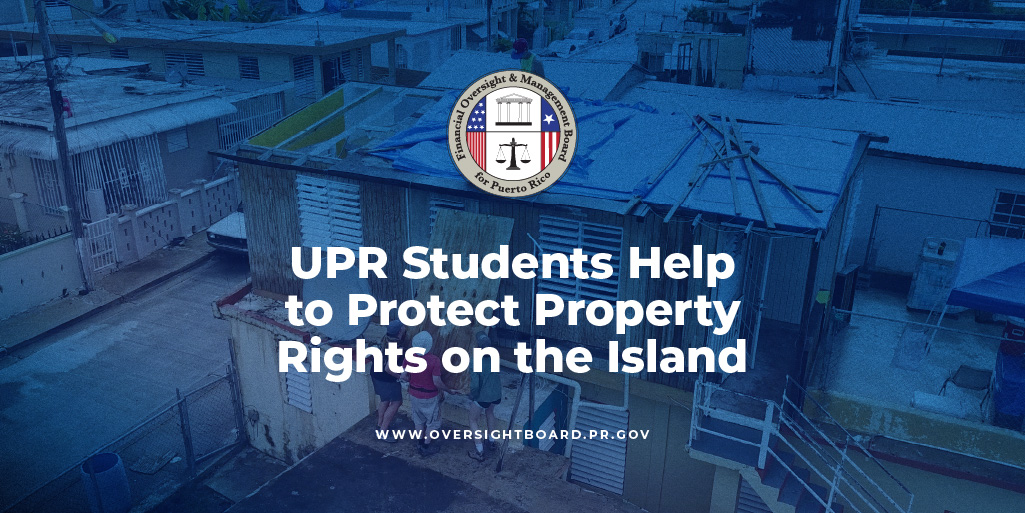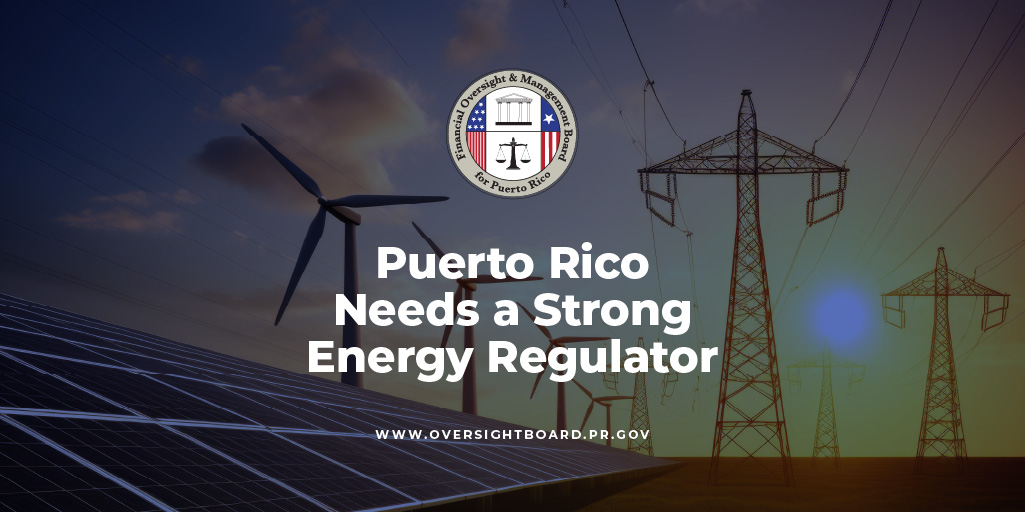Government procurement in Puerto Rico is responsible for some of the highest levels of spending in the economy. With that scale, complex and dysfunctional procurement can be eating up management time and money that could be better used elsewhere. The Commonwealth must modernize and improve its procurement systems to satisfy the citizens’ needs and safeguard the public interest. A necessity to get the maximum value of government purchases is having a single procurement policy, better technology, and transparency requirements.
The government should integrate information and communication technologies to replace and redesign paper-based procurement processes at all agencies. The FOMB recommends a Single Procurement Portal to handle all government purchases. Once all processes are systematized, an interface should be created for the public, where much of the information associated with government purchases is made available on a centralized website. By instituting best practices in procurement, the Commonwealth can save tax money, make better use of public resources, deliver better public goods and services, boost integrity, and prevent fraud and corruption.
Author: Arnaldo Cruz, Director of the FOMB’s Department of Research and Policy
Procurement in Puerto Rico
The shortcomings of government procurement in Puerto Rico are systematic and include having different procurement rules across the government (188 to be exact according to a government report), deficiencies in the vendor selection process, lack of competition, and faulty contract and award management. As an example, in 2017, Puerto Rico’s bankrupt utility PREPA signed a massive $300 million contract with a tiny, inexperienced Montana company to rebuild its damaged electric grid in the aftermath of the Hurricane María disaster. According to a report published by the OIG at Homeland Security, Whitefish Energy ended up charging Puerto Rico more than double the regular wages for utility crew line workers and higher-than-normal daily meal rates. Also, PREPA did not follow the open bidding process, which is normally required for federal reimbursement. As a result, significant Whitefish contract costs may not be eligible for Public Assistance (PA) funds, and PREPA may be at risk of not receiving full reimbursement for Whitefish contract costs.
In another example, the Department of Education took over two years to buy computers for students, even though funds were available for these purchases from the beginning of the process. The initial RFP was paralyzed by the courts due to challenges to the bid process. This was a major problem for the Department—not to mention the students. When the acquisition process stretches out over months or even years, the delays not only drive up costs but also make it more difficult for the government to serve their constituency and fulfill their mission, which is exactly what happened in this case, as the Department was unable to provide much-needed devices to students and teachers during the Covid-19 emergency.
Last but certainly not least, in April 2020, the Government of Puerto Rico committed more than $40 million to purchase rapid tests from two small companies with no prior experience distributing medical products, at a cost well above its market value. The test kits did not have FDA approval at the time. Although the order was later canceled and the money was recovered, the incident increased ongoing perceptions of incompetent and dysfunctional government contracting in Puerto Rico.
It is worth noting that government procurement in Puerto Rico is responsible for some of the highest levels of spending in the economy, because of the number of agencies needing to purchase different products and services for public services across a number of industries, including healthcare, education, and infrastructure. The total volume of public procurement for the Commonwealth (excluding PREPA, PRASA, HTA, and municipalities), totals over $4.4 billion for FY2021, or about 20% of the Commonwealth consolidated budget. With that scale, complex and dysfunctional procurement can be eating up management time and money that could be better used elsewhere. According to a recent report made by McKinsey, the government has among the highest potential savings of any sector. Worldwide, they estimate that the public sector could reduce its current purchasing bill by 15 percent, or nearly $1.5 trillion if its organizations were to adopt best-practice procurement disciplines.
Public procurement is also one of the government activities most vulnerable to corruption. According to the OECD Foreign Bribery Report (2014), more than half of foreign bribery cases occurred to obtain a public procurement contract. The direct costs of corruption include loss of public funds through misallocations or higher expenses and lower quality of goods, services, and works.A study by the World Bank in 2015 stated that corruption led to misallocation of public funds and substandard and insufficient services. The European Commission calculated that, in its Member States, around $163 billion is lost each year to corruption – only marginally less than the European Union’s total annual budget. In 2004, the University of Puerto Rico professors José Alameda, Eliezer Curet Cuevas, and Jeffrey Valentín estimated that corruption in Puerto Rico represented $3.3 billion between 1993 and 2000, or about $417 million a year.
Therefore, it is imperative for the Commonwealth to modernize and improve its procurement systems to satisfy the citizens’ needs and safeguard the public interest. In the 2020 Fiscal Plan, the government was required to consolidate 125 agencies into no more than 44 agency groupings and independent agencies. These consolidations would have facilitated the centralization of procurement functions, improve efficiency, and eliminated unnecessary administrative positions. However, so far, the Government has not made meaningful progress in procurement consolidations or improved operational efficiency.
A good procurement system can meet public needs in a timely fashion, secure value for money for the taxpayers, and protect competitive markets. That is why the Board continues to encourage the government of Puerto Rico to improve procurement practices and institute an adequate and timely degree of transparency in each phase of the public procurement cycle.
The Basics of Procurement
Public procurement refers to the acquisition by a government agency or any government-owned institution (i.e., PREPA) of goods or services, ranging from cars for the police department and textbooks for schools to financial and legal services, as well as large-scale construction works, such as roads, bridges, and airports. Public procurement refers to all the stages of the procurement process, covering the initial needs assessment, budget allocations, and initial market research through to the preparation of the proposal, evaluation of applications and award of contracts, and culminating with a purchase order, contract and receipt of product/service. Although not traditionally seen as part of the procurement process, contract implementation and administration, as well as auditing and evaluation, are also captured within the public procurement process. While there might be some variations, according to Transparency International, the procurement process can be broken down into 4 stages.
Exhibit A
The 4 stages of public procurement
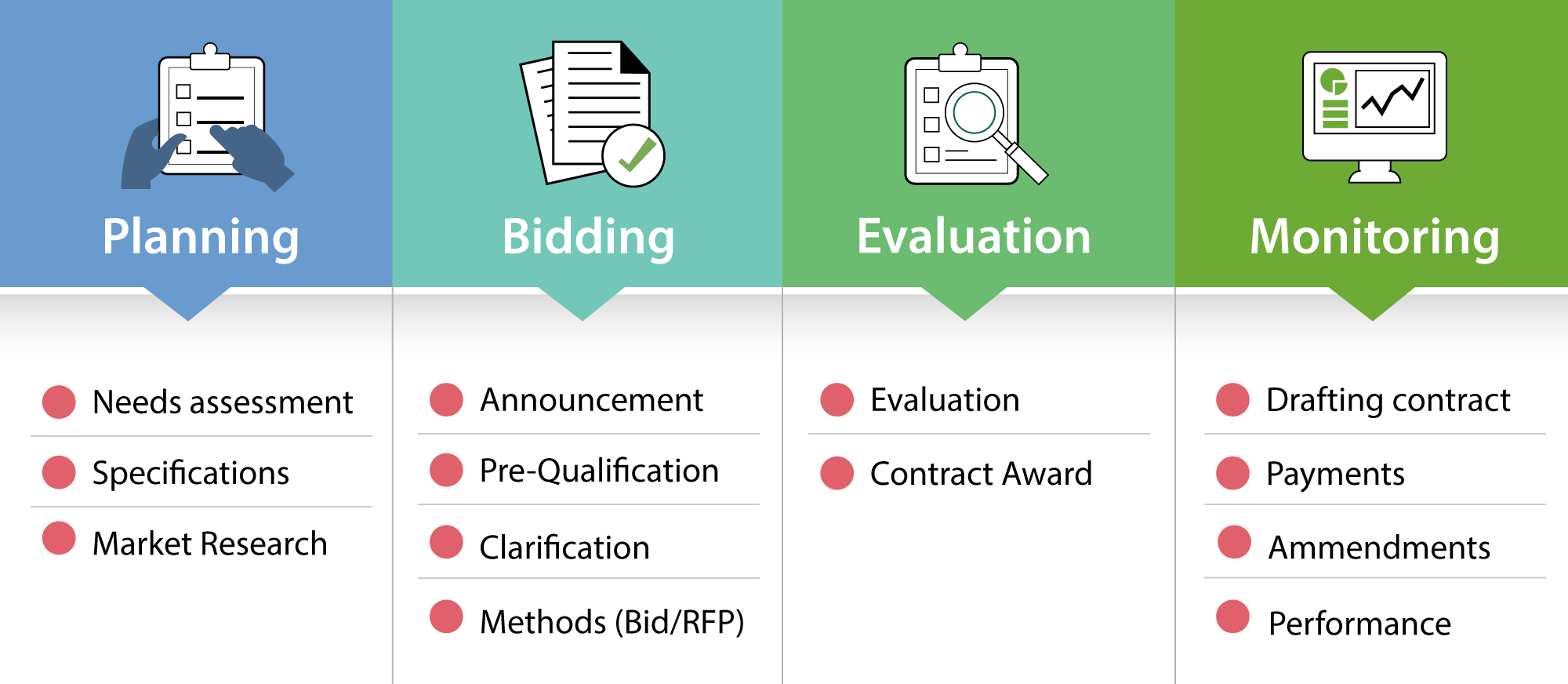
Integrity risks occur in every stage of the procurement process, from the needs assessment over the bidding phase to the contract execution and payment. The nature of the integrity risk may differ for each step, and red flags include undue influence, conflicts of interest, and various kinds of fraud risks. It is also critical to create ethical boundaries between departments involved in the procurement process. The handling of conflicts of interest among the various stages of procurement is a major concern in public procurement. Splitting responsibilities for planning, bidding, evaluation, and monitoring public procurement contracts is the concept of having different entities perform the tasks associated with these four phases of the procurement process. The main purpose is to prevent errors, conflicts of interest, and fraud or corruption, as well as to ensure effective checks and balances while strengthening the accountability of key players in the procurement process. Segregation of duties is, therefore, one way to reduce the cost of fraud and increase confidence in the integrity of public procurement. The emergence of the “Chinese Wall,” which is a virtual barrier erected to block the exchange of information between departments in an organization, has provided a convenient and successful solution as a means to self-regulate. The reliance on uncompromised information during the bid process points to the need to ensure that information confidentiality is present. A lack of information confidentiality can occur when a government official involved in the bid process derives personal gain by knowingly possessing a conflict of interest. This, in turn, corrupts the procurement process by awarding a bid to an unworthy recipient. Thereafter, information flow models and the Chinese Wall Model can be used as means of mitigating instances where conflicts of interest can occur.
Exhibit B
Common risks in stages of procurement*
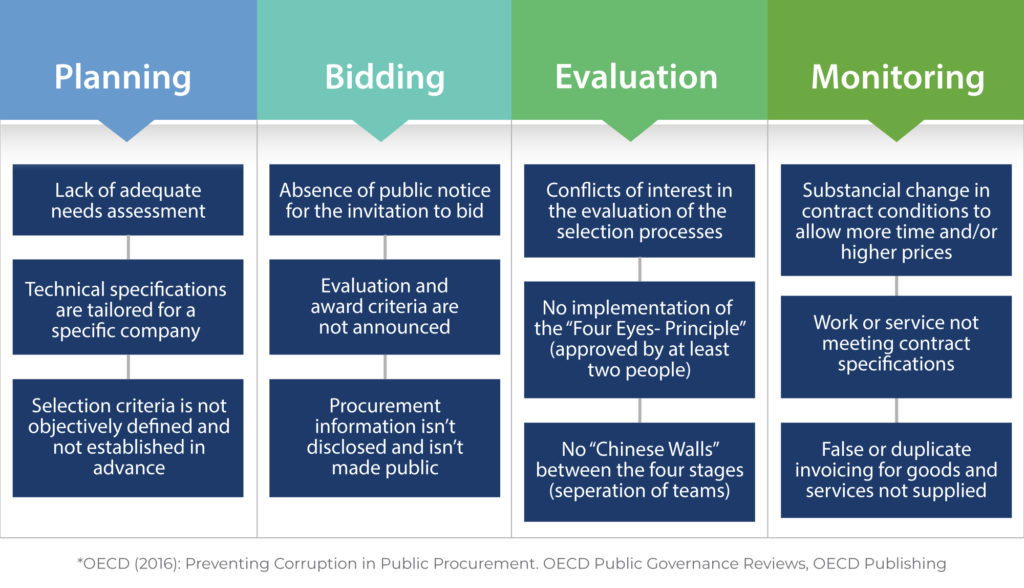
In general, the dollar amount of your purchase or contract impacts how much effort one must put into finding and evaluating the potential choices. If it is determined that procurement is necessary, the next step is to decide which procurement method is appropriate. Factors to be considered in this decision include:
- Type of project (for example, vehicles, professional services, architectural, engineering, etc.)
- Estimated cost (based on an independent cost estimate or ICE)
- Federal and state requirements
Since procurement method options depend in large part on the dollar value of the eventual contract, once a realistic estimated budget has been established, a government agency can select the most appropriate procurement method. Although there are variations across countries and states, the federal government does provide good guidance on procurement methods. The federal procurement methods which are related to the dollar amount of the procurement are: micro-purchases, small purchases, and large purchases. States may also have different names for these methods, or additional methods.
Exhibit C
Procurement methods in federal programs*
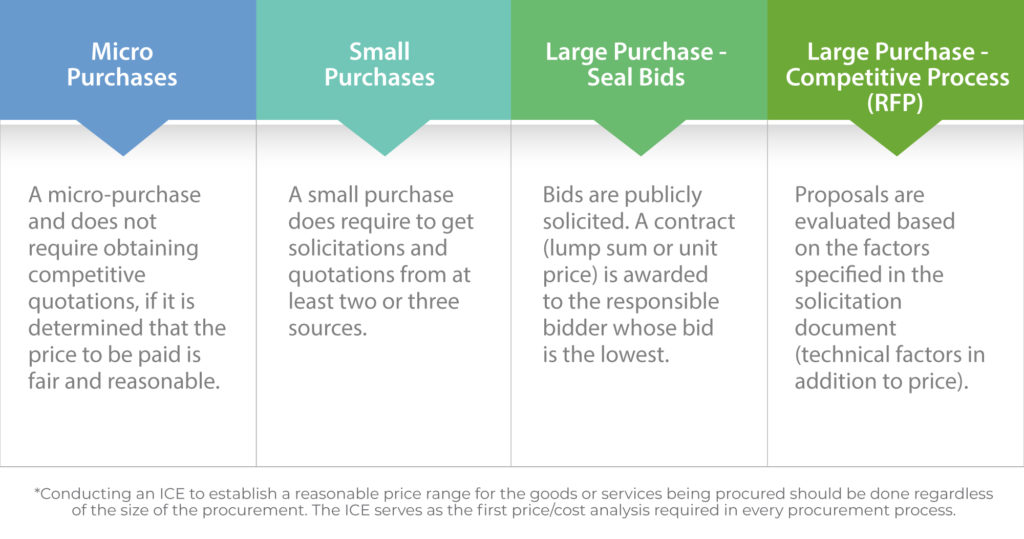
Public Procurement in Puerto Rico
The agency responsible for implementing public policy related to procurement in the executive branch is the General Services Administration (ASG for its Spanish acronym), which in turn must ensure that all government purchases are made quickly, efficiently and in a transparent matter. Despite the creation of ASG in 1971, the vast majority of government purchases in the Commonwealth are still made through internal independent agency processes. According to ASG, in 2017 there were 188 different procurement rules across the Commonwealth. Even within a government agency like the Department of Health, there are different rules, which explains the fact that we have more procurement rules than government agencies.
In addition, many commonwealth agencies manage their procurement processes on paper and use personal email and/or mobile phones to communicate with bidders. Although some agencies digitalize their procurement documents, they are usually stored on personal folders, which prevents adequate tracking systems. The key difference between digitalizing documents and digitalizing procurement is that the former only stores procurement documents and is static while the latter dynamically regulates the entire procurement process, from the bid announcement, evaluation, and monitoring.
There is also the issue of deteriorating skills in public procurement. According to the state comptroller, Yesmín M. Valdivieso, most of the purchasing personnel in the Commonwealth lack specialized knowledge of purchasing processes. The comptroller audits at the agencies often have the same findings over and over. The agencies recurrent issues are displayed in the next figure.
Exhibit D
Common Procurement Findings: Office of the Comptroller
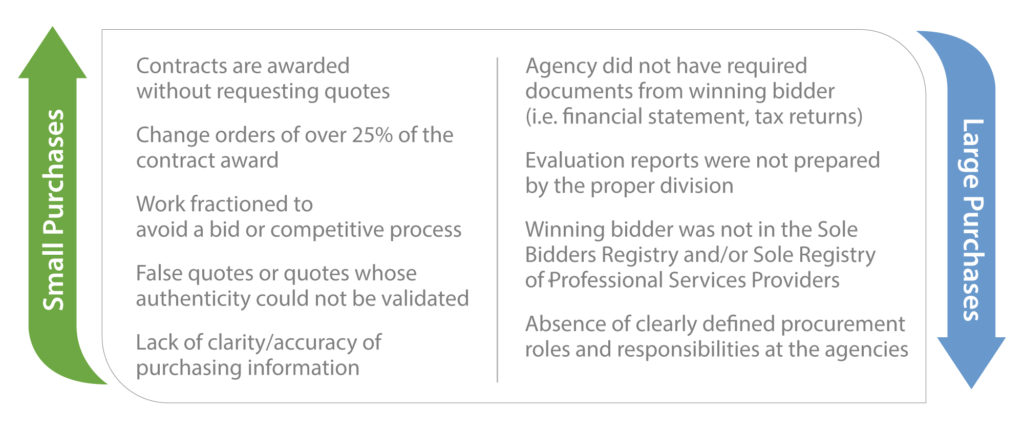
Incompetence and lack of knowledge are also obstacles to increasing the efficiency of public procurement procedures, which makes agencies more vulnerable to corruption. Further and continuous training is needed to educate the current and future procurement professionals, and create better qualified, durable teams. For example, Texas certifies its public employees in the processes of purchasing, contract development, and contract management. To be able to compete for a position in this area, you need to be certified.
Another issue in Puerto Rico is that most purchases are not made by open contractors awarded through a formal auction process. The lack of a contract negotiated through a formal auction process produces dozens of purchase orders for the same service, where agencies select the supplier through written quotes. This type of practice further fragments the purchasing process within an agency and limits the ability to obtain better prices and control its performance. Instead, agencies should utilize open contracts with the largest vendors and use purchase orders to track purchases under the terms of the contract to ensure proper management and compliance. A contract agreement that is awarded as the result of competition establishes price reasonableness, as soliciting competitive bids or quotes from qualified suppliers is the preferred method to establish a reasonable price and results in savings of much needed public funds.
Act 73-2019
In 2019, former Governor Rosselló signed legislation during this term to try to improve government procurement processes, this time giving the ASG more responsibilities/powers (Act 73-2019). Article 24 of Act 73-2019 states:
The Administration of General Services will be the only entity authorized to carry out and negotiate the acquisition of goods, works, and nonprofessional services. All government entities, regardless of the source of funds for the acquisition (state or federal), will acquire all goods, works, and nonprofessional services through the ASG.
It is important to emphasize that this statute excludes various government entities (called exempt entities), including the University of Puerto Rico, the State Elections Commission, the Aqueduct and Sewer Authority, the Electric Power Authority, the Highway and Transportation Authority, the Administration of Medical Services (Medical Center), the Cardiovascular Hospitals and the Workers Compensation Insurance Company. It also excludes professional services, which amount to just over $1 billion from the consolidated budget of $22 billion of General and Special Revenue Funds in FY21.
The public policy in Act 73-2019 calls for the centralization of government procurement processes to achieve greater savings. Thus, the main objective is fiscal. Although it is reasonable to want to centralize the vast majority of procurement in one agency, there are some challenges with this approach. There is certainly a degree of economy and efficiency to be achieved through the consolidation of procurement activities in one entity. The challenge is to have specialized knowledge or previous experience in particular areas, like health and technology. There are concerns with ASG’s capacity to manage the transition, which can result in significant delays of service. According to an ASG report, in 2017 only 1% of government contracts were processed through the agency. Therefore, assuming the agency has the capacity to handle that kind of volume is a stretch. Moving dozens of procurement employees to ASG from other agencies can also be a substantial undertaking and can cause major disruptions in existing purchases. The efficiency and attractiveness of the centralizing procurement in ASG should be measured in terms of how well this entity can satisfy the needs of all agencies and other key stakeholders.
On the other hand, the draft regulation provides ASG the authority to delegate procurement duties to agencies. As it happened in other areas government, like human resources management, under this provision, a gradual decentralization can also occur.
In October 14, 1975 Puerto Rico Government approved Act Number 5 with the mission of establishing a personnel management system for civil service in Puerto Rico, the Central Office of Labor Advice and Human Resources Administration (“OCALARH” by its Spanish acronym). However, OCALARH lost its operational role as a centralized human resources office for the government as it failed to maintain the level of technical expertise and a roster of top-notch experts to do the required tasks. As a result, the government’s policy between late 1980’s and 2017 was to recognize autonomy to the Individual Administrators and decentralize important operational and policy aspects of the administration of its human resources system through the approval of multiple Executive Orders. By 1995, all public agencies had become Individual Administrators and had their own human resources systems.
This is not to say that the government should not pursue centralized procurement. As stated before, the 2020 Fiscal Plan required the Government to consolidate the 125 agencies into no more than 44 agency groupings. The criteria used to design these consolidations vary. In some cases, these consolidations should focus on the competing efforts of multiple agencies, such as the Economic Development grouping, which is consolidating ten agencies into one. In other cases, the consolidations should serve to move services closer to residents, such as the Healthcare grouping, which will consolidate access points to important services like Medicaid. Consolidating procurement offices under 44 agency groupings will still generate considerable savings, reduce the number of processes while minimizing disruption in government purchases. This seems like a more viable approach than attempting to centralize 100 procurement offices in one agency.

Reforming Procurement in Puerto Rico
A complementary necessity to get the maximum value from those consolidations and centralization of procurement is having a single procurement policy, technology, and transparency requirements.
The first step to direct the improvement of the processes is to approve a single procurement regulation for the entire government. Standardized procurement processes and documents help ensure the predictability and systematic treatment of all vendors. Nonstandard bidding documents can create space for manipulation and lead to opaque decision-making. Act 73-2019 does provide for a single procurement policy and gives ASG the role of designing it. It also requires government entities to have an annual procurement plan ever year. These are good things and, if done correctly, can certainly improve procurement in Puerto Rico. However, instead of trying to centralize all procurement in one agency or attempt to manually oversee it, ASG should integrate information and communication technologies to replace and redesign paper-based procurement processes at all agencies. The Organization for Economic Co-operation and Development (OECD) countries have long used e-procurement systems to increase transparency and efficiency in public procurement. E-Procurement can provide on-demand access to relevant procurement information to all stakeholders, making contracting authorities more accountable to citizens.
Once you have one single procuring policy, you can transfer all the rules into a Single Procurement Portal (Portal). All agencies would be required to use this Portal to process all their procurement processes. Since there are federal programs like CDBG-DR that have a separate procurement policy, the Portal can be programmed so it can allow for different modules that adjust to each program’s requirements. The Portal can be developed using open-source software, which allows for rapid deployment and iteration for all government agencies and municipalities, at a fraction of the cost of proprietary systems. By partnering with open source specialist developers, the government sector can enjoy the agile, unrestricted integration capabilities of software that breeds innovation and, by doing so, break the vicious circle of inadequate funding for technology and reform efforts.
By integrating the rules in the Portal, you better ensure that agencies follow them since the system itself would not allow a deviation from what is established in the regulation. New technology tools are becoming increasingly sophisticated as they can include real-time transaction analysis, predictive models, anomaly detection, and algorithms to identify risks and stop potentially inappropriate payments long before they are processed. These anomalies can trigger an automatic notification to ASG and other corresponding agencies, like the Comptroller, in real-time. These agencies would have immediate access to documents for inspection, without waiting for the agency in question to provide them. By automating and standardizing procedures along the entire procurement cycle, you can significantly reduce the risk for human error and vulnerability to corruption. As an example, if the regulation states that you need three bids for a small purchase, the agency would not be able to move into the next part of the cycle until they upload the three bids in the Portal. Or if a supplier has not been certified by ASG, the system would not allow for them to submit a proposal, let alone win a solicitation. In case of suspicious observation, the contact person for the prevention of corruption may also have access to documents for inspection. The details of each procurement decision will be at the ASG’s fingertips on the Portal, allowing the manager to examine total expenditures quickly and efficiently, rather than filed away in paper form.
The Portal would also have standard templates for bid evaluation to only allow the award of the contract to the vendor with the highest score. The evaluating sheets would be available online at any time to be scrutinized by ASG, who would also be able to see the specific persons in the bid committee that evaluated each proposal. This Portal can also facilitate market access, thereby increasing competition and decreasing the administrative burden of procurement offices. Many times, agencies make bid announcements either through their website or a public notice in a newspaper. Vendors complain that they must be visiting agency websites to ensure they don’t miss any procurement notice, and often they find out there was a bid after a contract was awarded. Since Act 73-2019 states that any government supplier must belong to the Sole Bidders Registry and/or Sole Registry of Professionals, the Portal can automatically send an email to all the vendors that are in the Registry every time there is a bid announcement. All government suppliers can create an online profile and choose the types of notifications they want to receive from the various government agencies. In 2010, Georgia implemented a transparent, mandatory e-procurement system, which later became the inspiration for Ukraine’s ProZorro. By 2011, the total number of competitive tenders run in the country had risen from 1,933 to 33,000, which greatly increased market competition. Within five years, the country had saved US$400 million, according to the World Bank.
Another benefit of using information and communication technologies is robust reporting. Due to the paper-based nature of procurement in Puerto Rico, aggregated statistics and real-time reports are very limited. The Portal can provide statistical tools to ASG and other corresponding agencies with basic real-time statistics and the corresponding infographics, which can help evaluate the cost-effectiveness of the purchases and the efficiency of the entire procurement cycle for all government agencies. The central government will be able to automatically track expenses, identify spending patterns, and see if they are meeting policy targets (like buy local) in real-time. A group of public hospitals in the UK National Health Service pooled manufacturer and price data for generic medical products such as examination gloves and aprons. The hospitals used the data to aggregate demand and leveraged their collective purchasing power to achieve prices that were 15–50 percent better than the benchmarked best prices.
The last aspect would be transparency. Once all processes are systematized, an interface could be created for the public, where much of the information associated with all proposals for all agencies is made available in a centralized location, be it a formal or informal auction, an RFP or an RFQ. The Portal would have the information of the solicitation, the participating bidders, their respective scores or prices, and the award. A copy of the contract could also be accessed within the same Portal. With all this information available through a public interphase with searchable dashboards and API’s, there would be greater scrutiny in the procurement process for the entire government. Having transparent purchasing systems is one of the requirements to ensure that the money that the government spends reaches private providers in a clear and traceable way. When this information is not disclosed, it is easier to manipulate agency decisions. This type of transparency can transform mechanisms for citizen engagement and public accountability. In Paraguay, journalists at ABC Color analyzed open contracting data to reveal that the police had purchased 10 office chairs for $8,000, ten times their market value. The police claimed that an extra zero had been added to the invoice in error. However, tendering documents revealed that the price was indeed set at the inflated level. The contract was canceled before any payments were made[15]. To amplify the voice of citizens in the procurement process, Ukraine launched ProZorro, a tool for identifying corruption risks. Through ProZorro, citizens can submit feedback and report violations across the procurement cycle. More than 133,000 citizens have visited ProZorro and recorded 14,000 feedback reports, since the launch of the platform in November 2016. So far, around 50 percent of these cases have been resolved, including over 1,200 cases where vendors were changed as a result of feedback[16].
An integrated procurement system could significantly improve our procurement challenges, without having to create a highly complicated process to transfer the purchasing functions of dozens of agencies to ASG. ASG would retain responsibility for creating the single procurement policy, acquire the e-procurement technology, and deploy it to agencies. Since there is an issue of deteriorating skills in public procurement in all government agencies, ASG can focus on providing training in public procurement and the use of technology, instead of attempting to do procurement for the entire government.
Act 73-2019 creates a new Bid Board, affiliated to the Administration, with quasi-judicial powers, to evaluate and award, all bids/auctions for all government entities. However, with the proposed approach, the Bid Board proposed by Act 73-2019 would eventually not be necessary, since existing individual agency Bid Boards would be required to use the Portal for all bids and thus, would not be able to deviate from the single procurement regulation, which is the main purpose for consolidating individual bid boards in the first place. Any deviation in the system by an Agency Bid Board would automatically be sent to the ASG to determine if it warrants issuing administrative fines for violating the provisions of the law or the single procurement regulation. Since the new Portal will take time to design and deploy, the ASG Bid Board should remain in place until the system is fully operational at all agencies but only focused on purchases that meet a certain threshold (more than $1 million, for example).
On the other hand, the Review Board proposed in the statute would be necessary. Act 73-2019 proposes a Bid Review Board, attached to the ASG with a quasi-judicial power, empowered to review any challenge to the determinations or awards made by the agencies. The Bids Review Board has jurisdiction to evaluate and issue the orders and resolutions related to bid challenges, proposals, and/or sealed proposals calls and the related documents carried out in accordance with the provisions of this Regulation. This could be maintained and executed from ASG, which would be greatly simplified with the incorporation of information and communication technologies. The provision of an administrative review process by ASG will facilitate settlement of bid disputes in almost all instances, as ASG will be seen by suppliers as an independent party to ensure fairness and avoid abuses in public procurement as well as to help small businesses by acting as an impartial referee.
Emergency Purchases
Emergency procedures still need to be public and open. As seen recently at the Department of Health, the rush to secure supplies during a crisis can lead to poor sourcing, unqualified suppliers, and poorly written contracts, not to mention invite lack of integrity and potential corruption. While emergency procedures are needed to ensure flexibility during critical crisis periods, they must remain publicly accountable for every contract concluded and spent. The shift to emergency procurement has normally been enacted by individual emergency decrees that set out the rules that can be circumvented. Instead, ASG should establish emergency procurement, purchasing policies, and procedures useable during any potential emergency, natural or manmade disasters. This emergency policy would specify in advance the situations when non-competitive procurement is acceptable and identify who has the authority to approve certain amounts or types of procurement arrangements. As with non-emergency procurement, these alternative rules can be embedded in the Single Procurement Portal for agencies to make their emergency purchases. Upon the declaration of the emergency, ASG would make the emergency module available to certain agencies, while disabling the other regular purchasing modules. All information on purchases and contracts during the emergency will be published in real-time using the existing public interphase of the Portal. A great example is the Ukrainian government’s business intelligence tool that has a specific module to show all COVID-19 related emergency procurement and includes information such as the name of items, the price per item, terms, supplier, etc.
Public procurement involves the expenditure of large sums of public money, and given its magnitude, it is critical to protect the integrity of the public process so as to maximize the resulting benefits for society and to protect the competitive market. These proposed reforms can increase the number of suppliers and the amount of competition by making access easier and significantly enhancing transparency by centralizing all information related to the procurement process in a publicly available web portal. By doing this, the government of Puerto Rico can minimize opportunities for corruption by automating procedures and reducing the amount of discretion exercised by procurement officials and their personal contact with private sector representatives. Although these reforms can imply additional time and cost in the short term, in the long run, they will save time, reduce costs, and provide transparency to a process that is perceived by the citizens as filled with corruption. By highlighting good practices in Puerto Rico as well as areas for improvement, we hope to influence the thinking around needed reforms, and thus help the Commonwealth benefit from private sector growth and better value for money in the procurement of public goods, works, and services. In doing this, governments can save tax money, make better use of public resources, deliver better public goods and services, boost integrity, and prevent fraud and corruption.
Share on facebook
Facebook
Share on twitter
Twitter
Share on linkedin
LinkedIn

